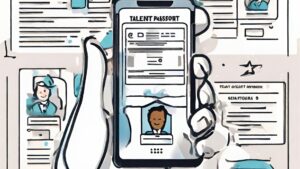Unlocking Competitive Advantage: The Imperative of LER Technology for ATS
Applicant Tracking Systems (ATS) are the lifeblood of modern recruitment, streamlining the complex and often labyrinthine hiring processes for organizations of all sizes. In today’s fast-evolving job market, staying ahead of the curve is critical for ATS providers. The emergence of Learning and Employment Records (LER) technology, coupled with AI-based systems, presents an unprecedented opportunity to revolutionize recruitment. This article delves deep into the reasons why ATS should embrace LER technology, how to implement it effectively, and the compelling ROI it promises.
The LER Revolution: A Paradigm Shift in Recruitment
1. Bridging the Skill Gap
The global skills gap is widening, with employers struggling to find candidates with the right skills for the job. By integrating LER technology, ATS can bridge this gap. LERs provide real-time data on candidates’ skills and qualifications, allowing recruiters to identify the perfect fit for their organizations with unprecedented accuracy.
Competitive Advantage: ATS equipped with LER technology can help employers discover hidden talent pools, enabling them to gain a strategic edge by recruiting individuals with unique and valuable skill sets.
2. Enhancing Candidate Experience
In the digital age, candidate experience is a cornerstone of recruitment. LER technology offers candidates a seamless way to document their skills, qualifications, and achievements, reducing the need for manual data entry. ATS that provide this capability stand out as user-centric platforms.
Competitive Advantage: An exceptional candidate experience leads to higher user retention, increased referrals, and a positive brand image, all of which contribute to a competitive edge.
3. AI-Powered Matching
The future of recruitment is undoubtedly AI-driven. By harnessing AI and machine learning, ATS can utilize the data-rich LER ecosystem to match candidates with job opportunities more efficiently. Predictive analytics can assess a candidate’s suitability based on skills, experience, and culture fit.
Competitive Advantage: AI-driven ATS provide employers with a shortlist of highly relevant candidates, saving time and resources. This accuracy sets them apart from traditional systems.
4. Quality Assurance
Quality hires are the lifeblood of any organization. LER technology enables ATS to perform in-depth skills and qualification verification, ensuring that the candidates presented to employers meet the required standards.
Competitive Advantage: Delivering high-quality candidates enhances an ATS’s reputation, making it a go-to platform for employers looking for top talent.
5. Facilitating Lifelong Learning
Learning is no longer confined to formal education. Continuous learning and upskilling are becoming the norm. By integrating LER technology, ATS can facilitate lifelong learning by allowing candidates to update their skill profiles seamlessly.
Competitive Advantage: ATS that promote continuous learning become trusted partners in career growth, encouraging users to return even after landing a job.
The Roadmap to Successful LER Integration
1. Collaboration with Startups
The LER ecosystem is still in its infancy, offering vast untapped potential. Collaborating with startups specializing in LER technology can provide ATS with innovative solutions. These startups often have a deep understanding of emerging LER standards and can offer agile, customizable solutions.
Competitive Advantage: Early collaboration allows ATS to shape the direction of LER technology, ensuring their platform remains at the forefront of the industry.
2. Data Security and Privacy
LERs are data-intensive, containing highly sensitive information. Ensuring robust data security and privacy measures is essential. Compliance with regulations like GDPR is non-negotiable.
Competitive Advantage: Airtight data security builds trust with users and differentiates ATS from platforms with lax privacy measures.
3. User-Centric Design
User experience is paramount. ATS should prioritize creating user-friendly interfaces that enable candidates to seamlessly upload and manage their LERs. Chatbots and AI-driven virtual assistants can enhance the user journey.
Competitive Advantage: A platform that prioritizes user experience gains a reputation for innovation and attracts a larger user base.
4. AI Integration
Harnessing the power of AI requires robust integration. ATS should invest in AI systems that can parse and analyze LER data effectively. Predictive analytics should be a core feature, providing value to both candidates and employers.
Competitive Advantage: AI-powered ATS deliver faster, more accurate matches, setting them apart from less advanced systems.
5. Ecosystem Integration
Collaboration is key. ATS should actively participate in building the broader LER ecosystem. This includes partnerships with educational institutions, employers, industry associations, and government bodies. A holistic approach ensures seamless transitions for job seekers from education to employment.
Competitive Advantage: Integration fosters a dynamic and interconnected platform that addresses all aspects of the candidate journey, attracting users and employers alike.
ROI: The Compelling Case for LER Integration
Investing in LER technology is not just a matter of gaining a competitive edge; it’s a strategic move that promises a compelling return on investment (ROI). Here’s why:
1. Increased User Base
A feature-rich ATS with LER technology attracts more users. As candidates recognize the value of LERs and AI-driven matching, they are more likely to choose platforms that offer these capabilities.
ROI: A larger user base means more revenue, expanding the business’s bottom line.
2. Enhanced Efficiency
Efficiency gains are one of the most immediate ROI benefits. AI-driven matching and data verification reduce manual labor for both candidates and recruiters, saving time and money.
ROI: Cost savings from increased efficiency translate directly into higher profitability.
3. Premium Subscriptions
Advanced features like AI-powered matching and in-depth skills verification can be offered as part of premium subscription packages, generating additional revenue streams.
ROI: Premium subscriptions boost revenue without significantly increasing operating costs.
4. Long-Term User Engagement
Lifelong learning and skills updates encourage users to stay engaged with the platform throughout their careers. This extended user lifecycle increases the lifetime value of each customer.
ROI: Long-term user engagement leads to sustained revenue growth.
5. Market Leadership
Early adoption and integration of LER technology position ATS as industry leaders. This leadership can translate into partnerships, acquisitions, and increased market share.
ROI: Market leadership provides access to additional revenue streams and business opportunities.
In conclusion, the integration of Learning and Employment Records (LER) technology, coupled with AI-based systems, is not just a strategic move for ATS; it’s a competitive imperative. By bridging the skills gap, enhancing the user experience, and embracing AI, ATS can differentiate themselves in a crowded market. Collaborating with startups, ensuring data security, and participating in the broader LER ecosystem are key steps in this journey. The compelling ROI of increased user bases, enhanced efficiency, and long-term user engagement cements the case for ATS to invest everything they have in LER technology. The future of recruitment belongs to those who seize this opportunity.





